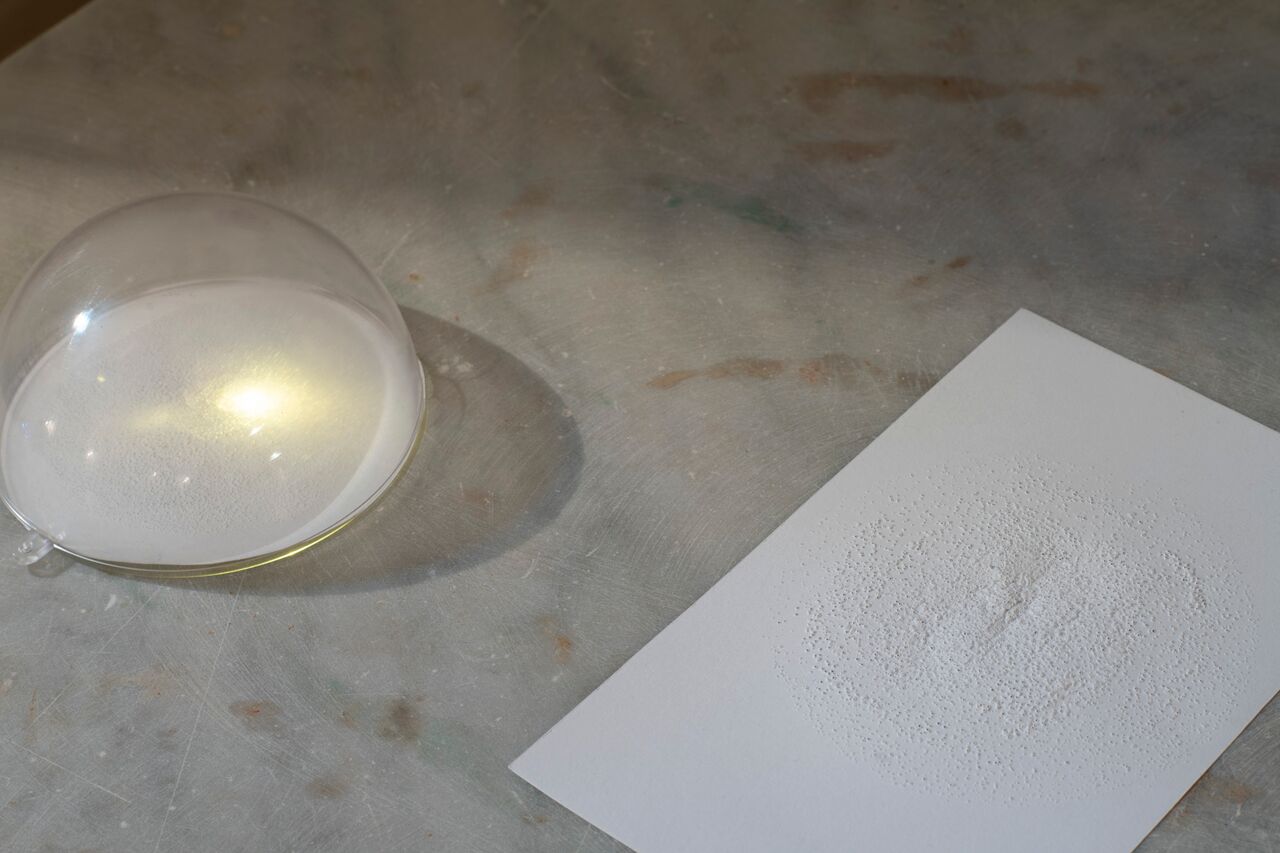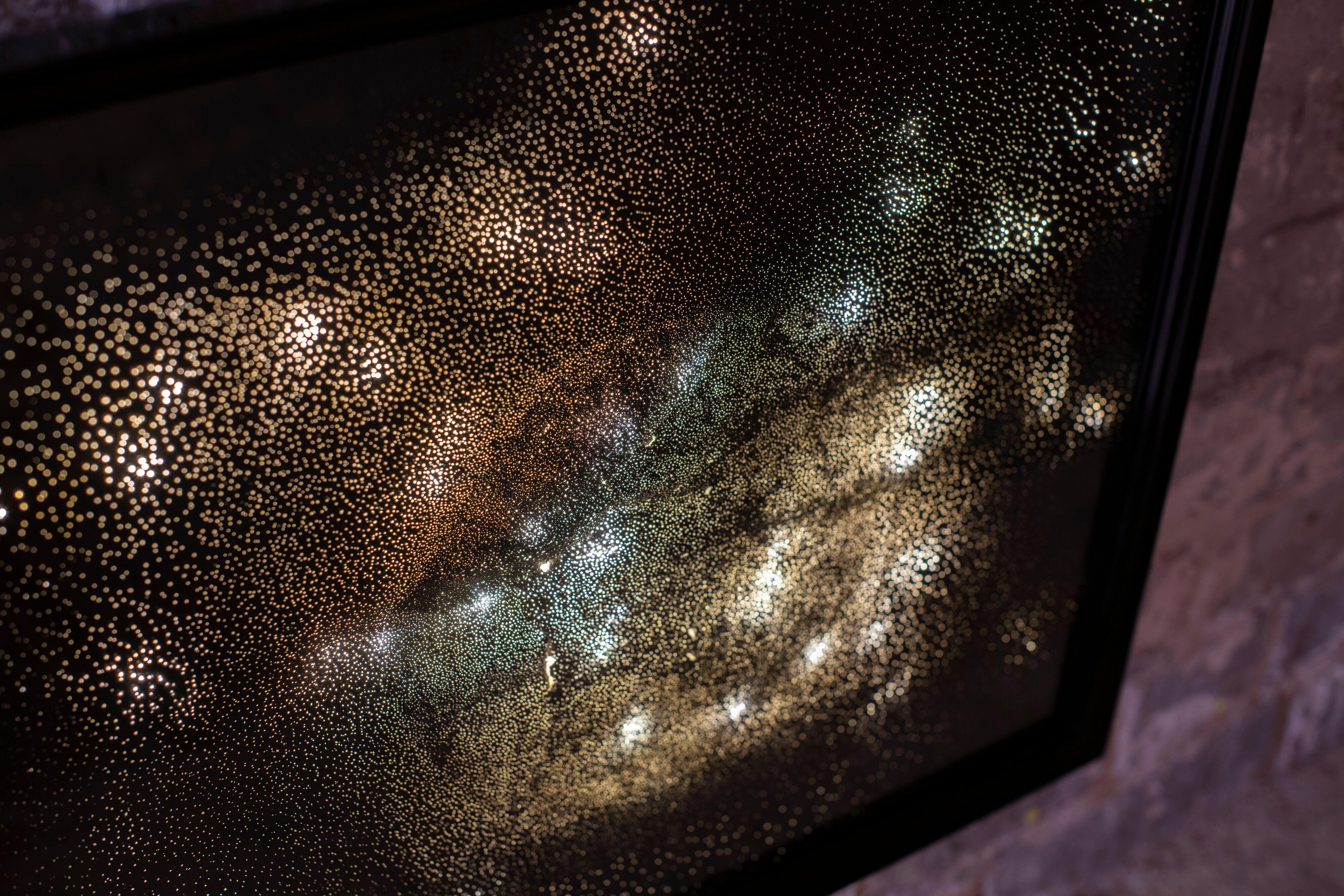︎ perspectives
(ongoing)
PERSPECTIVE III (NGC 457, NGC 6791, NGC 2360), 2022
Papier perforé, bois.
Triptyque de 360 cm x 120 cm (200 x 120 cm chacun). Produit en collaboration avec l’atelier bois de la Villette.
Punctured paper, wood.
Triptych of 360 cm x 120 cm (200 x 120 cm each). Produced in collaboration with the wood workshop of la Villette.
PERSPECTIVE (NGC 5139), 2019
Papier perforé, verre, métal, DEL.
40 x 50 cm.
Punctured paper, glass, metal, LED lights.
40 x 50 cm.
—




After spending three weeks in residence in a small village in Italy with the British collective Lumen Studios, I realized that two experiences had had a profound impact on me : that of having the possibility of observing an incalculable number of stars (compared to what I could see in the Paris suburbs), and that of observing a cluster of stars through a telescope – these groups of stars, sizes and distances seemed within reach to me. My first Perspective was carried out in such a way as to summon these two experiences : trying to transcribe the immensity of the sky on my scale, in a manual, imprecise way, while using an image of a globular cluster as a working basis. Thanks to a pucturing work with dry points of different sizes, this black sheet of paper was transformed on a light source.
Following this first exhibition at the St Pancras Crypt Gallery in London, I came across a book on Palo Mayombe : a syncretic religion very present in Cuba, developed by Congolese slaves – the country from which my parents come. It involved a meditation technique of “drawing a dot” to invoke the Great Spirit and ancestors, often by drawing a cosmogram, called Yowa. As I continued this research, I heard of slaves drilling it into the floor of a church in Savannah, Georgia (USA). The guide of the First African Baptist Church, built between 1855 and 1859, explains : “Beneath the wooden floor, the builders left a four-foot-high space, large enough to hide hundreds of slaves who followed the Savannah River towards freedom. They drilled holes in the ground in the cross and diamond shapes of an African prayer symbol, the Kongolese Cosmogram, and publicly worshiped its ancient meaning. Quietly, below, the runaways adored the light and air that the symbols allowed.”
This gesture, which I thought was intuitive, had been used by slaves of Congolese origin in the United States to allow them to breathe as they fled their condition. In what was the Kongo Kingdom, nganga (healers), like my great-grandmother, invoked Nzambi Pungu (the Great Spirit) and the ancestors during meditation rituals. In 2022, in France, for the first time, being aware of the scope of this gesture, I in turn invoked Nzambi Pungu and my cosmic ancestors – a way of getting closer not only to these stars that I see less and less, but also to a history, a culture and a legacy which has been fragmented by colonialism and imperialism. While waiting to continue this ritual in a new space that would welcome us, I continue my research between Paris and Kinshasa.
Following this first exhibition at the St Pancras Crypt Gallery in London, I came across a book on Palo Mayombe : a syncretic religion very present in Cuba, developed by Congolese slaves – the country from which my parents come. It involved a meditation technique of “drawing a dot” to invoke the Great Spirit and ancestors, often by drawing a cosmogram, called Yowa. As I continued this research, I heard of slaves drilling it into the floor of a church in Savannah, Georgia (USA). The guide of the First African Baptist Church, built between 1855 and 1859, explains : “Beneath the wooden floor, the builders left a four-foot-high space, large enough to hide hundreds of slaves who followed the Savannah River towards freedom. They drilled holes in the ground in the cross and diamond shapes of an African prayer symbol, the Kongolese Cosmogram, and publicly worshiped its ancient meaning. Quietly, below, the runaways adored the light and air that the symbols allowed.”
This gesture, which I thought was intuitive, had been used by slaves of Congolese origin in the United States to allow them to breathe as they fled their condition. In what was the Kongo Kingdom, nganga (healers), like my great-grandmother, invoked Nzambi Pungu (the Great Spirit) and the ancestors during meditation rituals. In 2022, in France, for the first time, being aware of the scope of this gesture, I in turn invoked Nzambi Pungu and my cosmic ancestors – a way of getting closer not only to these stars that I see less and less, but also to a history, a culture and a legacy which has been fragmented by colonialism and imperialism. While waiting to continue this ritual in a new space that would welcome us, I continue my research between Paris and Kinshasa.
︎ perspective (NGC 5139) during the solo show “Out of sight”, at the Lumen Crypt Gallery (St John on Bethnal Green) in London, 2019.

︎the first tests before the creation of my first perspective, created during the Lumen : Atina Residency, 2018. ︎ John Hooper

Exhibition views ︎
100% l’expo, La Villette, Paris, France, 2022. Photo : © Quentin Chevrier
Falling stars / Stelle Cadenti, Saint Pancras Crypt Gallery, London, United Kingdom, 2019. Photo : Lumen Studios
100% l’expo, La Villette, Paris, France, 2022. Photo : © Quentin Chevrier
Falling stars / Stelle Cadenti, Saint Pancras Crypt Gallery, London, United Kingdom, 2019. Photo : Lumen Studios